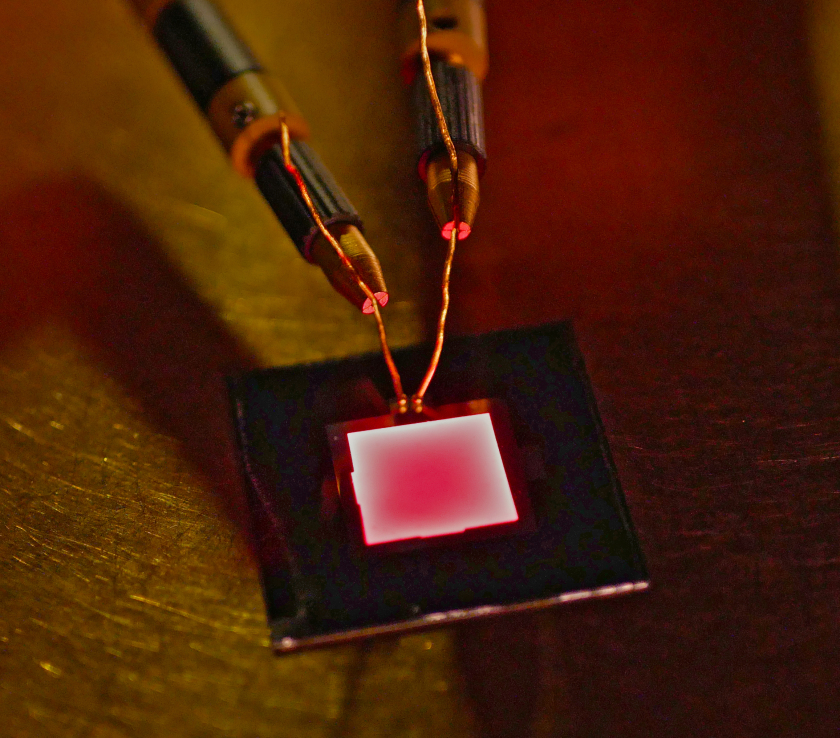Department Perovskite Tandem Solar Cells
Development of New Contact Materials
The interfaces to charge-selective layers dictate the performance of perovskite solar cells. While tailoring of the perovskite absorber is important for the maximum achievable performance (see also Tailoring Perovskite Properties), currently the charge-selective layers are limiting the solar cells by non-radiative recombination in highly efficient solar cells and also limit their applicability depending on how versatile the layers are. We investigate new contact materials with reduced non-radiative recombination losses and improved charge extraction, as well as the optimization of transparent conductive oxides that serve as electrodes in single junction and especially tandem solar cells:

Electroluminescence of a perovskite top cell. Picture: E. Köhnen / HZB
- The introduction of hole-selective self-assembled monolayers (SAMs) served as a key development for our tandem solar cells (in close collaboration with Kaunas University of Technology): These consist of molecules designed to form a densely packed layer with molecular thickness on arbitrarily formed oxide surfaces autonomously. By optimization of the molecular structure and energetic alignment between electrode, SAM and perovskite, we have explored the importance of highly passivated hole-selective interfaces [1,2]. Furthermore, the advantage of conformal coverage enabled us to demonstrate record-efficiency perovskite/CIGSe tandem solar cells with rough, as-deposited CIGSe surface [2].
- A further strategy for improved charge transport layers that we have developed is to combine two different materials and benefit from the unique advantages of both materials: We demonstrated that a double-layer of PCBM and TiO2 enables increased device performance due to more favorable energetic alignment of the PCBM and hole-blocking capabilities of the TiO2 layer [3]. In a further study, we combined undoped Spiro-OMeTAD, which has good hole extraction properties but low conductivity with water-free PEDOT supplying conductivity and efficiently passivating the interface with to the perovskite [4].
- In the view of performance optimization, damage reduction and upscaling of perovskite-based solar cells, we are researching new TCO materials, and new sputter deposition techniques: Currently, the best perovskite tandem solar cells feature an indium zinc oxide (IZO) top electrode. IZO thin films stand out due to their good optoelectronic properties but during the sputter deposition of these layers, plasma and particles may cause damage at the interface to subjacent layers. In our group, we investigate these processes and optimize the deposition of IZO.
Key Publications:
- Al-Ashouri, A.; Köhnen, E.; Bor, L.; Magomedov, A.; Hempel, H.; Caprioglio, P.; Márquez, J.; Morales Vilches, A.B.; Kasparavicius, E.; Smith, J.A.; Phung, N.; Menzel, D.; Grischek, M.; Kegelmann, L.; Skroblin, D.; Gollwitzer, C.; Malinauskas, T.; Jošt, M.; Matic, G.; Rech, B.; Schlatmann, R.; Topic, M.; Korte, L.; Abate, A.; Stannowski, B.; Neher, D.; Stolterfoht, M.; Unold, T.; Getautis, V.; Albrecht, S.: Monolithic perovskite/silicon tandem solar cell with >29% efficiency by enhanced hole extraction. Science 370 (2020), p. 1300-1309
doi:10.1126/science.abd4016
Open Access Version (available 01.12.2021)
(available 01.12.2021) - Al-Ashouri, A.; Magomedov, A.; Roß, M.; Jost, M.; Talaikis, M.; Chistiakova, G.; Bertram, T.; Márquez, J.A.; Köhnen, E.; Kasparavicius, E.; Levcenco, S.; Gil-Escrig, L.; Hages, C.; Schlatmann, R.; Rech, B.; Malinauskas, T.; Unold, T.; Kaufmann, C.A.; Korte, L.; Niaura, G.; Getautis, V.; Albrecht, S.: Conformal monolayer contacts with lossless interfaces for perovskite single junction and monolithic tandem solar cells. Energy & Environmental Science 12 (2019), p. 3356-3369
doi: 10.1039/C9EE02268F
Open Access Version - Kegelmann, L.; Wolff, C.; Awino, C.; Lang, F.; Unger, E.; Korte, L.; Dittrich, T.; Neher, D.; Rech, B.; Albrecht, S.: It Takes Two to Tango-Double-Layer Selective Contacts in Perovskite Solar Cells for Improved Device Performance and Reduced Hysteresis. ACS Applied Materials & Interfaces 9 (2017), p. 17245-17255
doi:10.1021/acsami.7b00900 - Kegelmann, L.; Tockhorn, P.; Wolff, C.M.; Márquez, J.A.; Caicedo-Dávila, S.; Korte, L.; Unold, T.; Lövenich, W.; Neher, D.; Rech, B.; Albrecht, S.: Mixtures of Dopant-Free Spiro-OMeTAD and Water-Free PEDOT as a Passivating Hole Contact in Perovskite Solar Cells. ACS Applied Materials &Interfaces 11(2019), p. 9172-9181
doi:10.1021/acsami.9b01332
